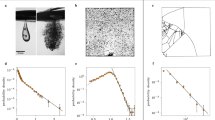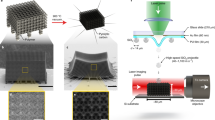Abstract
COMMINUTION and crushing are important processes designed to break large particles into smaller ones by compression. Under such compression, cracks can propagate through a particle to split it into two or more fragments of smaller size and increase surface area if the material is sufficiently brittle. The appreciation of brittleness as applied to solids under compression is, therefore, basic to an understanding of comminution. This note analyses the brittleness of an ideally shaped particle subjected to compressive forces. New equations, based on the old ideas of Rittinger1 and Griffith2 are presented to explain the fracture of such a particle and these are verified by experiments on a model material, specially chosen to demonstrate the effects at the macro-level. The equations state explicitly that compressed brittle particles should increase in strength as they are made smaller, a fact well known from macroscopic fracture results. In addition, the equations predict a critical particle size, verified by experiment, below which crack propagation is impossible under compressive forces. Bodies smaller than this appear ductile and are squashed flat when attempts are made to comminute them by crushing.
This is a preview of subscription content, access via your institution
Access options
Subscribe to this journal
Receive 51 print issues and online access
$199.00 per year
only $3.90 per issue
Buy this article
- Purchase on Springer Link
- Instant access to full article PDF
Prices may be subject to local taxes which are calculated during checkout
Similar content being viewed by others
References
Von Rittinger, P. R. Lehrbuch der Aufbereitungs Kunde (Ernst and Korn, Berlin, 1867).
Griffith, A. A. Phil. Trans. R. Soc. A 221, 163 (1920).
Timoshenko, S. History of strength of materials, 58 (McGraw-Hill, London, 1953).
Rice, G. S. & Enzian, C. US Bur. Mines Bull. 303, 5 (1929).
Gaddy, E. L. Virginia Poly Tech. Inst. Eng Extension St. Ser. 112 44, 10 (1956).
Jellinek, H. H. G. Proc. phys. Soc. Lond. 71, 797 (1958).
Holland, C. T. Min. Congr. J. 48, 325 (1962); 48, 466 (1962).
Evans, I. & Pomeroy, C. D. Strength Fracture and Workability of Coal ch. 3 and 4 (London, Pergamon, 1966).
Kendall, K. J. mater. Sci. 11, 1267 (1976).
Kendall, K. Proc. R. Soc. (in the press).
Lowrison, G. C. Crushing and grinding ch. 1–5 (Butterworths, London 1974).
Gregg, S. J. Chemy Ind. 611 (1968).
Steier, V. K. & Schonert, K. Dechema Monog. 69 Pt 1, 167 (Dechema, Frankfurt, 1972).
Boddy, R. G. H. B. Proc. Conf. Ultrafine Structure of Coals and Cokes, 336 (BCURA, London, 1943).
Tabor, D. Br. J. appl. Phys. 7, 159 (1956).
Parish, B. M. Br. J. appl. Phys. 18, 233 (1967).
Millard, D. T., Newmann, P. E. & Phillips, T. W. Proc. phys. Soc. B 68, 723 (1955).
Shaw, M. C. Proc. natn. Acad. Sci. U.S.A. 40, 394 (1954).
McClintock, F. A. & Argon, A. S. Mechanical Behaviour of Materials 495 (Addison Wesley, Reading USA, 1966).
Author information
Authors and Affiliations
Rights and permissions
About this article
Cite this article
KENDALL, K. The impossibility of comminuting small particles by compression. Nature 272, 710–711 (1978). https://doi.org/10.1038/272710a0
Received:
Accepted:
Issue Date:
DOI: https://doi.org/10.1038/272710a0
This article is cited by
-
The critical state of crushable granular sand
Acta Geotechnica (2024)
-
Role of PEEK as Intermediate Layer in the Cold Spray of Hydroxyapatite Coating
Journal of Thermal Spray Technology (2023)
-
Micromechanics of composites with interface effects
Acta Mechanica Sinica (2022)
-
Site dependence of surface dislocation nucleation in ceramic nanoparticles
npj Computational Materials (2021)
-
Size Effects of Brittle Particles in Aerosol Deposition—Molecular Dynamics Simulation
Journal of Thermal Spray Technology (2021)
Comments
By submitting a comment you agree to abide by our Terms and Community Guidelines. If you find something abusive or that does not comply with our terms or guidelines please flag it as inappropriate.



